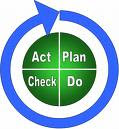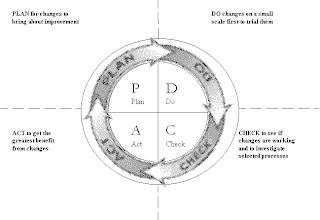Quality assurance covers all the activities including design, development, production, installation, servicing and documentation. The introduction of the rules: "fit for purpose" and "do it right the first time". It includes the guideline of the quality of raw materials, assemblies, products and components; services related to production; and management, production, and review processes.
One of the commonly used prototypes for QA management is the PDCA (Plan-Do-Check-Act) approach.
Plan–Do–Check–Act Cycle
The concept of the PDCA Cycle was originally developed by Walter Shewhart, the pioneering statistician who developed statistical process control in the Bell Laboratories in the US
Description
The plan–do–check–act cycle (Figure 1) is a four-step model for carrying out change. It is just as a circle that has no end, the PDCA cycle should be repeated again and again for continuous improvement. Use the PDCA Cycle to coordinate your continuous improvement efforts. It both emphasizes and demonstrates that improvement programs must start with careful planning, must result in effective action, and must move on again to careful planning in a continuous cycle.
Figure 1: Plan-do-check-act cycle
When Plan-Do-Check-Act come into play?
It is a model of continuous improvement.
When the starting of a new improvement project.
When developing a new or improved design of a process, product or service.
When defining a repetitive work process.
When planning data collection and analysis in order to verify and prioritize problems or root causes.
When implementing any change.
Plan-Do-Check-Act Procedure
Plan. Recognize an opportunity and plan a change. Plan to improve your operations first by finding out what things are going wrong (that is identify the problems faced), and come up with ideas for solving these problems.
Do. Test the change. Carry out a small-scale study. Do changes designed to solve the problems on a small or experimental scale first. This minimises disruption to routine activity while testing whether the changes will work or not.
Study. Review the test, analyze the results and identify what you’ve learned. Check whether the small scale or experimental changes are achieving the desired result or not. Also, continuously Check nominated key activities (regardless of any experimentation going on) to ensure that you know what the quality of the output is at all times to identify any new problems when they crop up.
Act. Take action based on what you learned in the study step: If the change did not work, go through the cycle again with a different plan. Act to implement changes on a larger scale if the experiment is successful. This means making the changes a routine part of your activity.
. The diagram below lists the tools and techniques which can be used to complete each stage of the PDCA Cycle.


No comments:
Post a Comment